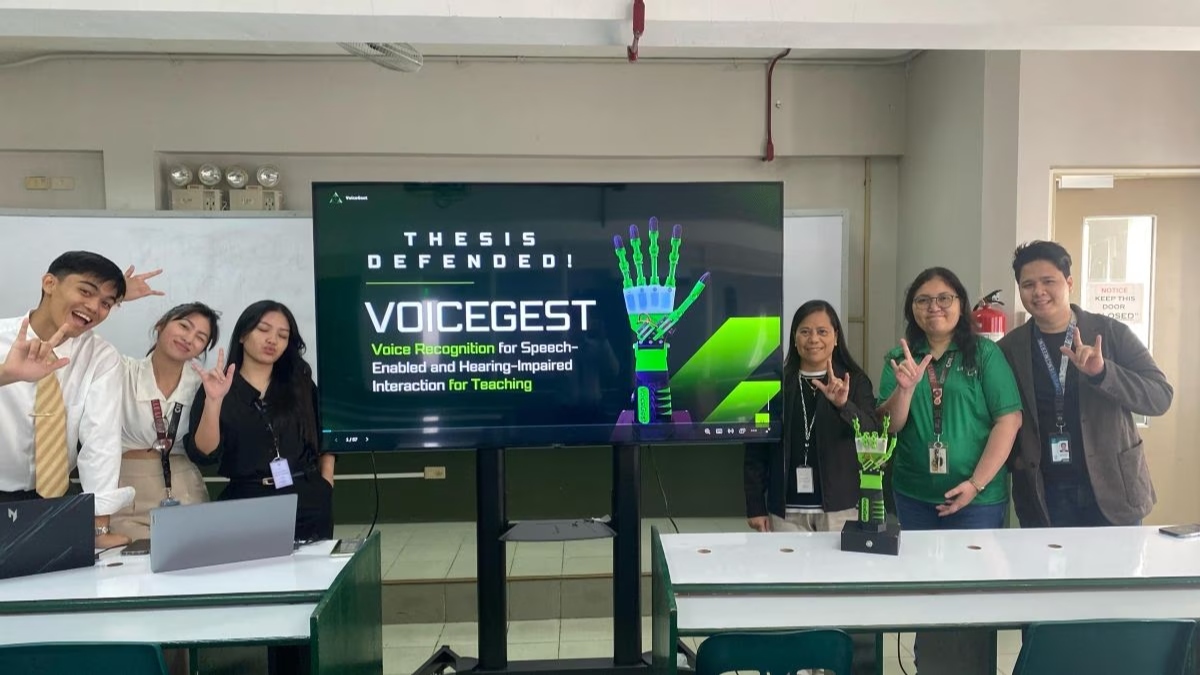A group of Computer Engineering students from De La Salle Lipa has created a cost-efficient robotic hand that translates spoken words into Filipino Sign Language (FSL), aiming to support inclusive education for learners with hearing and speech impairments.
The invention, called VOICEGEST, was developed by fourth-year students Althea Lat, Alexie Shane Lenesses, and Nathanael Malabanan, under the guidance of their thesis adviser Engr. Imelda Martin. The project was born out of their desire to help a local SPED school in Malvar, Batangas, which struggles with a shortage of teachers.
“Kami din talaga ‘yung nakapag-isip nung robotic hand that can do sign language so that we can help students with disabilities,” said team leader Althea Lat in an ABS-CBN News report, describing how their personal encounters with underserved learners fueled their advocacy.
VOICEGEST features a 3D-printed robotic hand operated by servo motors and controlled through a custom mobile app. The app uses voice recognition and touch functions to trigger hand movements that display letters, numbers, and simple words in sign language.
“If you want the robotic hand [VOICEGEST] to produce the sign language for letters in the alphabet, for example, letter A, B, C… you just have to tell it to the mobile phone or speak it up… [Then] the robotic hand will form the sign language for letters,” explained Engr. Martin.
The device also caters to users who cannot speak by allowing them to press commands on the app instead. “Then if you don’t have the capability, for example, you are PWD… you’re deaf or mute… you may just click on [the] letter A button in the mobile app… then practically the same, the robotic hand will show the sign language for that particular letter,” she added.
Initially mistaken by children as a toy, the robot quickly became a learning tool in real-world settings. “Akala nila laruan siya [VOICEGEST] but in reality… that can actually… help them to learn more,” Lat shared.
What sets VOICEGEST apart is its affordability. With an estimated cost of just P15,000 to P20,000, it significantly undercuts similar assistive devices priced up to P100,000. “Ang puhunan lang talaga namin here is our knowledge and our skills na we gain in our school,” Lat said.
The team is now seeking a patent for VOICEGEST and is working on enhancements, including adding audio features to the app and expanding the robot’s sign vocabulary. “Currently we’re working on our upgrades on our robot since we joined the competition… There’s a lot of suggestions from the panel or the judges na we should add sounds,” Lat noted.
At present, the robot can mimic 25 of the 27 degrees of human hand motion. “Once we [do] that… the functionality of VOICEGEST will gonna be limitless,” said Engr. Martin, envisioning broader applications in hospitals, government offices, and customer service centers.
Following their win at the MURATA ROBOLUTION 2025 competition, the team is now exploring partnerships and funding to bring VOICEGEST into full development. “We consider our robot as version 1 palang and additional funding would allow us to enhance its features and expand its capabilities,” Lat added.
With eyes on future innovations, the team remains focused on making communication more accessible for everyone. “Our goal is to promote inclusivity and we hope it serves as a bridge to better communication and understanding,” Lat said.






